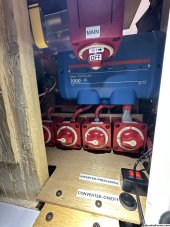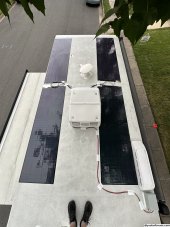randybobandy
New Member



Equipment (already installed and running):
- Batteries - qty 2 Roypower PowerUrus 12v 100ah LiFePO4 wired in series for 24v (rated for 50A continous charge / 100A continuous discharge) [user manual]
- Inverter/Charger - Sungoldpower 24v 4000w w/ built-in 50amp charger [user manual]
- SCC - EPEVER Tracer4215BN 40A 150V w/ MT-50 remote display [user manual] [MT-50 user manual]
- Solar Panels - qty 4 BougeRV 200w CIGS wired in series [user manual]
- Battery Monitor - Victron BMV-712 500A shunt w/ optional temperature sensor [user manual]
- I will occasionally have relatively high discharge rate (60-70amps max...most of the time much lower)
- I will frequently fast-charge at the max rated continous charge rate of 50amps.
- I need to squeeze out as much battery capacity as safely possible - meaning charge to 100% SOC and discharge deeply. (this is due to weight constraints, my batteries are undersized but I can't add more batteries as I'm almost exceeding payload capacity of my RV)
- I will only use the system for approximately 40-50 days per year, so 40-50 charge/discharge cycles. I don't expect to keep the RV for more than 10 years so as long as the batteries last that long I'll be happy. So 50 days per year x 10 years = ~500 charge/discharge cycles.
- Given my planned usage profile, do you think I can realistically expect the batteries to last >10 years without substantial capacity loss?
- What Depth of Discharge target should I choose to meet my requirements/goals without risking damage to the batteries? Can I go to 100% every single time if needed (or maybe 95% target is safer, to avoid triggering the BMS low voltage cutoff repeatedly)? What's the max you'd choose in my situation?
- When we're not actively using the RV I plan to put the system into unattended storage (could be from 1 week to 3 months). I plan to discharge batteries to 50-70% SOC, then fully de-energize the system and leave the batteries disconnected. Is that a good storage SOC target?
- Which charging profile should I pick for the AC fast-charger? (Sungoldpower inverter/charger - more info below)
- Sungoldpower Inverter/Charger Charge Parameters:
There are 7 different charging profiles to choose from that allow you to adjust 2 parameters - "Fast mode" and "Float mode". Preset #7 is for LiFePO4 and has fast mode 14.0 / float mode 13.8 which seem kind of low for my use case? Preset #4 is for Lithium/Sealed Lead Acid and has fast mode 14.4 / float mode 13.6 which seems to be better suited. Would you agree Preset #4 is better for my use-case where charging as quickly as possible is important? More info about how the charger works on pg.7-8 of the user manual.
- Sungoldpower Inverter/Charger Charge Parameters:
- I need help in choosing the appropriate settings for my solar charge controller (EPEVER Tracer4215BN) and battery monitor (Victron BMV-712). I filled in the tables below based on my best guess with all the information I could find but I'm really not super confident with most of it....most of the recommended/example settings that I have seen online seem to be designed to maximize lifespan of the battery (at the cost of usable capacity) so I don't think I can use those values for my nonstandard scenario. Please review tables below and let me know if you think I should change anything.
- I'm also not quite sure if/how my AC charger's behavior should play into the config for the solar charge controller and/or battery monitor. Is there any concern here that the two chargers won't play well together?
EPEVER Tracer4215BN Settings: | Config 12v (24v) | Notes |
|---|---|---|
| Temp comp. coeff | 0 mv / C / 2V | Setting based on PowerUrus battery user manual recommendation |
| over volt disconnect | 14.7 (29.4) ? | Setting based on PowerUrus battery user manual recommendation |
| charge limit | 14.6 (29.2) ? | Setting based on PowerUrus battery user manual recommendation |
| over volt reconnect | 14.4 (28.8) ? | Setting based on PowerUrus battery user manual recommendation |
| equalize charging voltage | 14.4 (28.8) ? | Setting based on PowerUrus battery user manual recommendation |
| boost charging voltage | 14.4 (28.8) ? | Setting based on PowerUrus battery user manual recommendation |
| float charging voltage | 13.6 (27.2) ? | Setting based on PowerUrus battery user manual recommendation |
| boost reconnect charging voltage | 13.2 (26.4) ? | Setting based on PowerUrus battery user manual recommendation |
| low voltage reconnect | 12.4 (24.8) ? | Setting based on PowerUrus battery user manual recommendation |
| under voltage warning reconnect voltage | 12.4 (24.8) ? | Setting based on PowerUrus battery user manual recommendation |
| under voltage warning voltage | 12.0 (24.0) ? | Setting based on PowerUrus battery user manual recommendation |
| low voltage disconnect voltage | 11.2 (22.4) ? | Setting based on PowerUrus battery user manual recommendation |
| discharge limit voltage | 11.0 (22.0) ? | Setting based on PowerUrus battery user manual recommendation |
| equalize time | 0 min to disable | PowerUrus manual says 120min but I think 0min to disable makes more sense |
| boost time | 120min | Setting based on PowerUrus battery user manual recommendation |
| Battery Charge SOC | 100% | Epever says "The setting is some spare setting, will not effect on your system, please ignore it." so I guess it doesn't matter what I put here. I think maybe this is only used if you select SOC charge mode instead of Volt.Comp. charge mode. |
| Battery Discharge SOC | 5% ? | Epever says "The setting is some spare setting, will not effect on your system, please ignore it." so I guess it doesn't matter what I put here. I think maybe this is only used if you select SOC charge mode instead of Volt.Comp. charge mode. |
| Victron BMV-712 Config Parameter | Config 12v (24v) | Notes |
|---|---|---|
| Battery Capacity | 100AH | |
| Charged Voltage | 14.0 (28.0) ? | |
| Discharge Floor | 5% ? | |
| Tail Current | 4% (4 amps) ? | |
| Charged Detection Time | 3min ? | |
| Puekert Exponent | 1.05 | |
| Charge Efficiency Factor | 99% ? | |
| Current Threshold | 0.10A | |
| Time to Go Averaging Period | 3min | |
| Zero Current Calibration | ZERO | |
| Synchronize | SYNC | |
| Relay Mode | DFLT | |
| Battery Starts Synchronized | Disabled | |
| Low voltage alarm/clear | 12.0/12.4 (24.0/24.8) ? | |
| High voltage alarm/clear | 14.7/14.6 (29.4/29.2) ? | |
| High temperature alarm/clear | 45°C / 43°C (113°F / 109°F) | The battery manual says max operating temp for charge cycle is 113F and discharge 131F...I settled on the lower of the two since I don't expect it to get that hot anyways and this is just a warning for unlikely edge-case scenario. |
| Low temperature alarm/clear | 2°C / 4°C | Going with this so I have some heads up when it's getting close to danger level. The batteries have low-temp protection built-in but with this alarm I can have some notice to get them warmed up before it gets to that point. |
| Temperature coefficient | 0.5°C ? | Victron recommends 0.5°C but PowerUrus manual says to turn off temperature compensation on charge controllers so not sure what to choose? |
Thank you in advance!!
Attachments
-
PowerUrus S12100A-S12100H-S12200A-S12200H_User_Manual_Welcome_Guide.pdf1.5 MB · Views: 0
-
SUNGOLDPOWER LFP 4000W INVERTER-CHARGER-ATS.pdf2.5 MB · Views: 0
-
EPEVER MT50-Manual-EN-V3.5.pdf375.1 KB · Views: 1
-
Victron BMV-712 Manual_BMV_and_SmartShunt-pdf-en.pdf7.2 MB · Views: 0
-
 20230823_225917806_iOS.jpg766.3 KB · Views: 4
20230823_225917806_iOS.jpg766.3 KB · Views: 4


